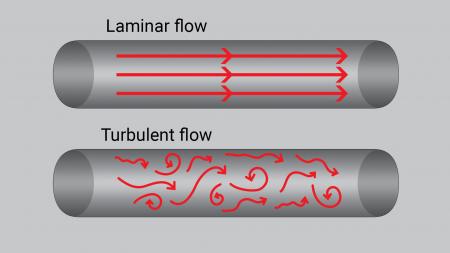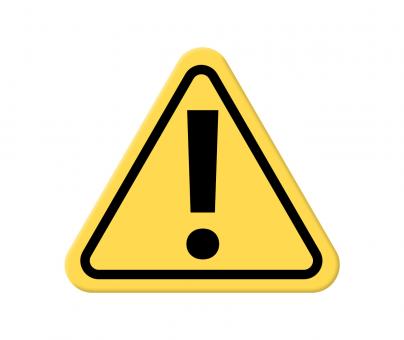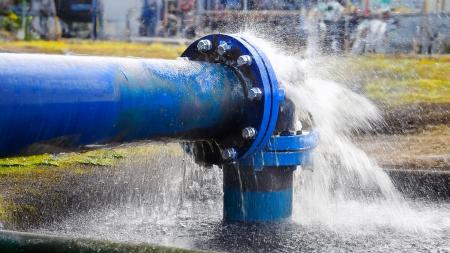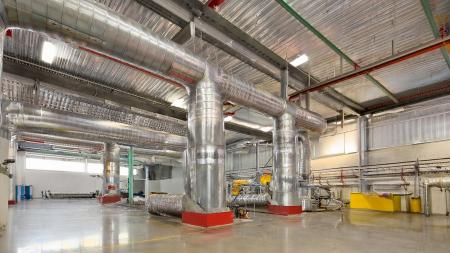In many companies in the industry there is a real chance of a gas explosion.
The Dutch standard NEN-EN-IEC 60079-10-1 indicates the principles for determining the danger zone classification. Following this, the Dutch practice guideline NPR 7910-1 discusses its implementation and the actual classification into danger zones. This article discusses the main points of this hazard zone classification with regard to gas explosion hazard. It will discuss:
- Legislation
- Ignition
- Release of combustible substances
- Mixing with air
- Danger zones
- Ignition sources - temperature class
- Gas groups
- Danger zone classification
- Required data
- Hazard Sources
- Ventilation
- Limitation of the danger zone
The experts at Dinnissen Process Technology are available to answer all your questions:
Get in touch with Juul Jenneskens 077 467 3555
Legislation
Wherever flammable liquids and gases are used in industry, there is a risk that they come into contact with oxygen, which could result in a fire or explosion. It is evident that this can be prevented by ensuring that the combination of flammable substances, oxygen and an active ignition source is excluded.
The ARBO regulations, Article 7 of Directive 1999/92 / EC, prescribes that the employer establishes a danger zone classification if situations with explosive atmospheres occur in the company. The classification to be drawn up is based on the frequency and duration of the presence of the explosive atmosphere.
The NEN-EN-IEC 60079-10-1 standard describes the principles of classification. Its implementation is central to practice guideline NPR 7910-1 and applies to flammable gases, mists and liquids and flammable gases that have condensed into liquids.
Ignition
A flammable gas or vapor from a flammable liquid or solid can ignite if a certain ratio of air is added. Ignition can be started by activating an ignition source. A “spontaneous” start of ignition is also possible if the temperature of the gas-air mixture is above the ignition temperature.
The result of the ignition is a heating of the mixture, the formation of combustion products and usually a (locally) rapid volume increase, coupled with a local pressure increase that runs like a pressure wave in front of the flame front. This pressure wave can travel through the air for quite some time and its force will gradually diminish. The concentration of the burning mixture as well as the reaction speed and the heat of combustion determine the force of the pressure wave.
If the igniting mixture is in an enclosed space with obstacles, turbulence can occur. This then causes a more intense combustion and an even more powerful pressure wave.
If there is a low concentration of flammable gases, a blowtorch can occur without creating a noticeable pressure wave.
Release of combustible substances
Flammable liquids can be vaporized. The vapor pressure and the exit temperature are important factors for the exit of vapor from a liquid. When the vapor pressure is higher than atmospheric pressure, the liquid will boil and flammable vapor is rapidly released. Vapor can also be released below boiling temperature. The most influential factors in that case are the temperature of the exiting liquid, the evaporation rate, the surface on which the liquid lies and the ambient temperature.
Mix with air
As indicated above, ignition can take place if the combustible gas has mixed sufficiently with air. The speed of mixing depends in particular on the following:
- the turbulence of the air,
- the speed of outflow,
- the density of the fabric.
The gas-air mixture can only be ignited within a certain mixing ratio. The upper explosion limit refers to the minimum gas-air ratio that the mixture needs to ignite. Above a certain gas-air ratio, combustion will no longer take place. This is called the lower explosion limit. If several flammable gases are involved, the explosion limit of the mixture can be easily calculated using the explosion limits of individual gases.

Laminar flow and turbulent flow
Danger zones
Flammable substances can be released and mixed with air at many places in an installation. The release can be part of normal business operations, but can also be the result of leaks from, for example, pumps, agitators, pipes or during transshipment. All places where flammable substances can be released are called danger zones. The places where these released substances can collect are also part of the danger zones.

Hazard zone
In companies where there is a risk of explosion, it is mandatory to make a hazard zone classification. Practical guideline NPR 7910-1 offers sufficient guidance to determine this classification in a structured manner
Ignition sources - temperature class
There are many causes that can ignite a combustible mixture. This mainly concerns hot surfaces, flames, sparks, static electricity, radiation, ultrasound and chemical reactions.
The auto-ignition temperature is the lowest temperature at which a gas-air mixture can be ignited. If it concerns a mixture of gases, then the lowest auto-ignition temperature of the various gases must of course be chosen. Equipment present in installations must have a lower temperature than the auto-ignition temperature. Because the temperature is such a determining factor for ignition, the equipment is divided into temperature classes T1 to T6. Regarding the maximum permissible surface temperature, T1 has a value of 450 oC and T6 a value of 85 oC.
Gas groups
There are many types of gases and vapors. These are divided into two main groups. Group I contains underground gas that only occurs in mines, an example of this is mine gas. Group II contains all flammable gases and vapors that occur in industry. Subsequently, group II was divided again into gas group IIA, IIB and IIC. Examples for gas group IIA are propane, butane and natural gas, for gas group IIB ethylene, ethanol and carbon monoxide and for gas group IIC hydrogen and acetylene.
Only equipment that is suitable for a particular subgroup may be used. The equipment may be used for a lower subgroup, not for a higher one.
Danger zone classification
A danger zone classification is a tool to analyze and classify places where explosions can occur. First of all, a division can be made between dangerous and non-dangerous areas.
Non-hazardous is an area where no measures need to be taken to eliminate the hazard from ignition sources.
These measures are necessary for hazardous areas. There are three types of hazardous areas:
- Zone 0: explosive atmosphere is present all the time or for long periods.
- Zone 1: there is a high probability of the presence of an explosive atmosphere, between 0.1% and 10% of the operating time.
- Zone 2: chance of the presence of an explosive atmosphere is small, less than 0.1% of the operating time.
The classification is a three-step plan:
Determining whether hazard classification is necessary.
- Determination of the type of danger zone, zone 0, zone 1 or zone 2.
- Determination of the size of the zone.
- Determining the type of danger zone also depends on the ventilation conditions. The size of the zone is determined, among other things, by the estimate of how much hazardous substance can be released and how it will spread. Far from the location of the released substance, the dilution with air will be so great that the concentration falls below the lower explosion limit and there is no longer an explosion risk. This forms the boundary of the danger zone.
An easier and more practical method to determine the size is based on 3 principles:
- The hazard sources are classified according to two sizes of the released flow rate, one smaller than 1 g / s and 1 g / s up to and including 10 g / s.
- The danger zone has the shape of a sphere, the center of which is the place where the dangerous substance is released. The radius is the greatest distance where explosive mixtures can still be located under the most unfavorable ventilation conditions.
- The entire space where the hazard source is located is considered a danger zone.
Required data
In order to determine the hazard zone classification, it is necessary to know which flammable substances can occur. These substances can be divided into gases, gases and liquids that have been compressed into liquids. It is mandatory to visualize the amount of combustible substance that may be released, despite the fact that in practice minimal amounts will not pose a risk.
Hazard sources
The code of practice lists three classes of situations where flammable substances can occur:
Continuous sources of danger, such as vents and open vessels
- Primary hazard sources, for example leaking gaskets and drip trays
- Secondary range, for example flanges, screws, taps and valves
- Pipe fittings are not considered a source of danger.

Leaking flange
Ventilation
The location of the hazard source also influences the classification into danger zones. The determining factor is whether the source of danger is located in the open air, in an open building or in a closed building.
In the case of a closed building, the ventilation conditions can have an influence. Five ventilation conditions are defined in the code of practice, namely no ventilation, limited ventilation, artificial room ventilation, artificial local ventilation or a large building.
The guideline further defines how to determine whether the ventilation capacity is “moderate” or “sufficient”. Where applicable, the guideline indicates how the capacity can be calculated for each type of ventilation condition.
Limitation of the danger zone
Danger zones are often bordered by obstacles in the vicinity. This could be walls or dikes, gutters or ditches, cellars or wells or a sloping roof. There may be openings in the boundaries between danger zones. These openings are also a potential source of danger. In the standard they are classified into 5 types, namely A, B, C, D or locks. The hazard class of the opening can then be determined as the hazard source via a table.

Ventilation in a factory

Name: Juul Jenneskens
Advisor
Please feel free to contact me if you have any questions about this subject. My team of colleagues and I are ready to answer!
Get in touch with Juul Jenneskens 077 467 3555 [email protected]
Do you prefer to request a consultation directly?
